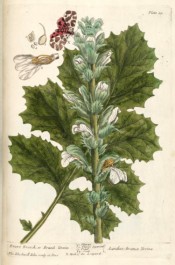Acanthus mollis L.
Fully hardy, clump-forming perennial with obovate, deeply-lobed, dark green leaves, and 1m long racemes of white flowers with purple-shaded bracts in summer. To 1.5m. [RHSE, Hortus].
Horticultural & Botanical History
Botanically described by Linnaeus in 1753 [Sp.Pl. vol.2/1753].
Introduced to Britain in 1548. [JD]. ‘Bear’s Breech, or Brank Ursin. Acanthus, Branca Ursina. The stalks grow to be two foot high, the leaves are a shining dark green colour; the flowers are white. It is said that the ancients took the pattern of their foliage work from the leaves of this plant. It is cultivated here in gardens; its native place being Italy, Spain, and the southern part of France; it flowers in July. This plant is used in glisters and baths for obstructions: and for the stone and gravel. The herb women sell the leaves of the Helleboraster, or Bear’s foot, or Sphondylium, or Cow-parsnip, instead of this plant, to those that are ignorant.’ [Blackwell pl.89/1737].
History at Camden Park
Listed only in the 1857 catalogue [T.17/1857]. Present in the gardens today. Naturalised in all eastern states of Australia.
Notes
Acanthus mollis Graf & Noë ex Nees (1847) = Acanthus longifolius Poir.
Acanthus mollis Riedel ex Nees (1847) = Acanthus spinosus L.
Published Feb 15, 2009 - 01:29 PM | Last updated Apr 21, 2011 - 12:34 PM
| Family | Acanthaceae |
|---|---|
| Category | |
| Region of origin | Southern Europe, North Africa |
| Synonyms | |
| Common Name | Bear’s breeches |
| Name in the Camden Park Record | Aecanthus mollis |
| Confidence level | high |


